VW ID. Buzz First Drive Review: Instantly recognizable (and likable)
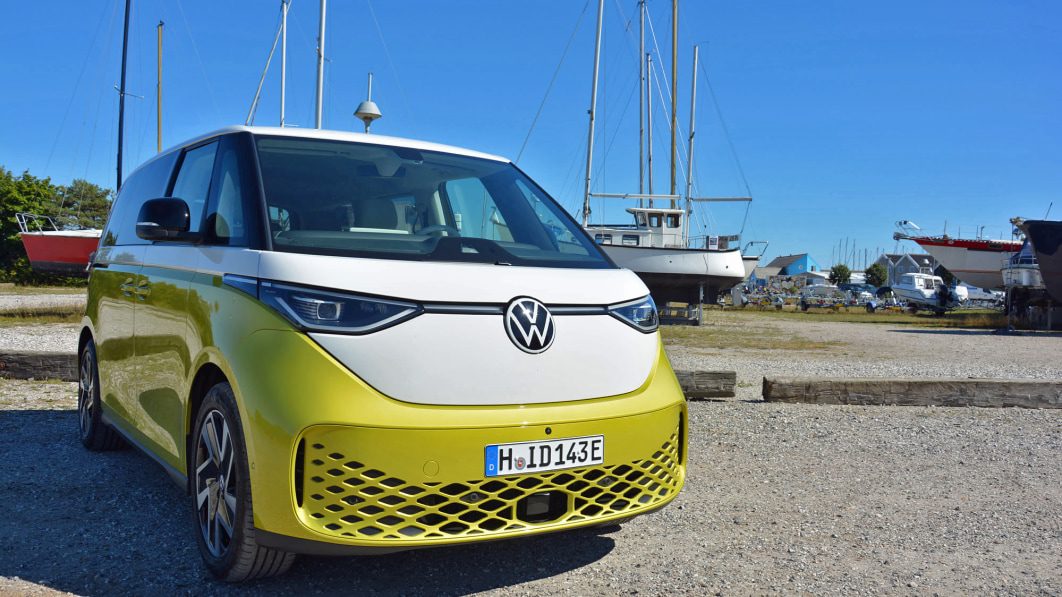
COPENHAGEN, Denmark — One interesting aspect of attending a launch event is that the folks who live and work along the drive route see the car for the first time. Some models fly under the radar. The only person who recently noticed the refreshed Volkswagen Polo was an Austrian woman whose lawn I accidentally parked it on to take photos. Others draw crowds everywhere they go. Lamborghinis, of course, but I also unexpectedly spent almost as much time explaining the Citroën C4 Cactus as I did driving it. Unveiled in 2022, the Volkswagen ID. Buzz falls in the latter category.
“It’s the new …” I started to explain to the middle-aged, bike-riding couple.
“Ja, ja, we know — it’s the new Volkswagen Bulli!”
Even in Denmark, which isn’t the mecca of car culture, the heritage-inspired van turned head after head. The difference between the Buzz and other head-turners is that nearly everyone knew what they were looking at. They’d spent years waiting see it in the metal. The reaction was more “finally, it’s here!” than “what the hell is this UFO?”
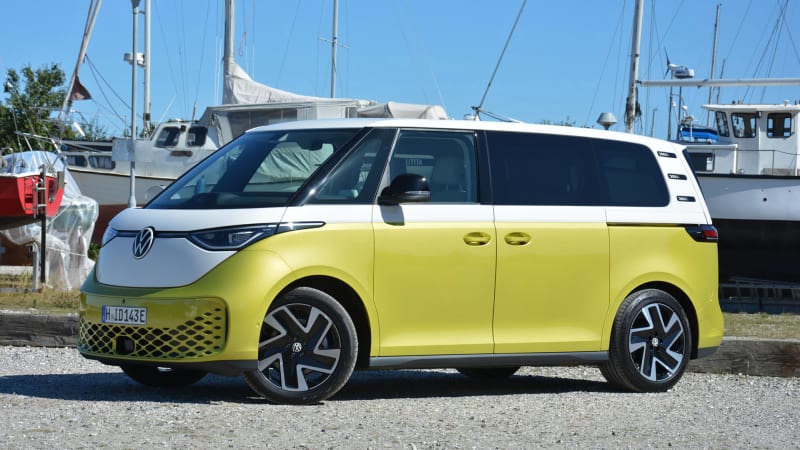
The last time Volkswagen created such a buzz was when it introduced the New Beetle in 1997. That’s fitting because, in a way, the Buzz fills the gap left by the modern-day Beetle when it was discontinued after 2019 and stands proud as the brand’s new style icon. On a secondary level, it concludes a project that Volkswagen has tinkered with on and off for longer than 20 years. The Buzz may be new, but Volkswagen has been toying with resurrecting the emblematic Bus since unveiling the V6-powered Microbus Concept at the 2001 Detroit auto show.
Volkswagen showed a pair of Bus-inspired concepts called Bulli and BUDD-e, respectively, in the 2010s but neither received the proverbial green light for production. Why? Well, it depends on who you ask, but the general consensus is that issues related to safety regulations and that market demand prevented both design studies from moving beyond the concept stage. It wasn’t until the ID.Buzz made its debut at the 2017 Detroit auto show that Volkswagen shifted the project into high gear. In the 1950s, when the first Bus roamed the world’s roads, high gear meant fourth. In the 2020s, it’s first — the Buzz is electric.
In terms of design, not a lot has changed over the past five years. Designers toned down some of the concept’s more futuristic-looking styling cues, like the front and rear lights, and the Buzz received exterior door cameras as well as door mirrors instead of cameras. It also gained a space: Volkswagen expanded the name from ID.Buzz to ID. Buzz. To the consternation of copy editors everywhere, the names ID.3 and ID.4 will remain spaceless. The rest is pretty much what we were promised in 2017: the Buzz’s overall proportions are as boxy and old Bus-like as Volkswagen could make them while still passing a crash test; the “you are the crumple zone” solution of the 1950s doesn’t fly in the 2020s. The Buzz isn’t as retro as, say, the New Beetle but it remains recognizable as the split-window van’s heir.
Here’s where the water gets murky: while the Buzz is headed to North America by 2024, what you see in our gallery isn’t exactly what you’ll see at your local Volkswagen dealer. We’ll get a long-wheelbase van that hasn’t been unveiled yet, and Volkswagen stressed it’s too early to provide details about it. For context, the European-spec, short-wheelbase Buzz that I drove in Denmark stretches 185.5 inches long (including a 117.6-inch-long wheelbase), 78.1 inches wide, and about 75.8 inches tall — it’s roughly 18 inches shorter and 5 inches taller than a 2022 Toyota Sienna and almost exactly as wide. It weighs a Ford F-150-like 5,447 pounds due largely to the battery pack that’s under the passenger compartment.

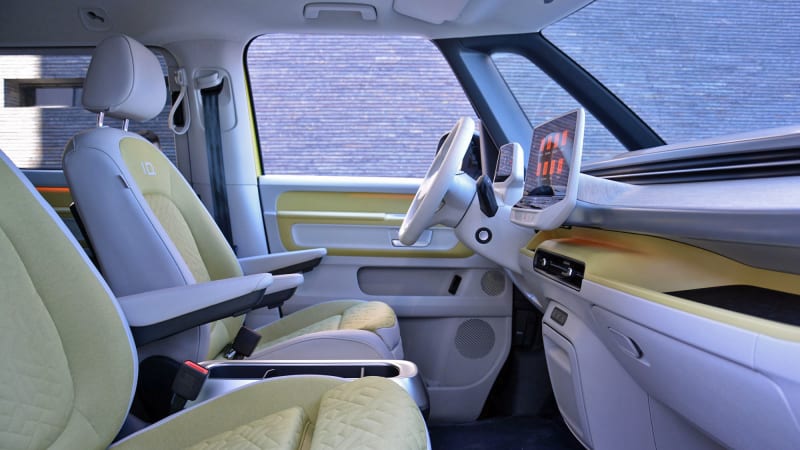

Looking beyond the retro-inspired suit, the Buzz represents Volkswagen’s return to America’s minivan segment. The cabin certainly feels the part: it’s spacious, well-lit, and cleverly laid out. Sitting high, the driver faces a three-spoke steering wheel, a 5.3-inch digital instrument cluster borrowed from the ID.4, and a huge dashboard with horizontal trim that augments the sense of width. The familiar, generally disliked infotainment system is displayed on either a 10- or a 12-inch touchscreen depending on the configuration and the floating center console clears up space between the center stack and the front seats. You can slide from the driver’s seat to the passenger’s seat even if you don’t have the flexibility of an Olympic gymnast. The build quality is pretty good overall but it doesn’t take much poking and prodding to find hard plastics.
Sliding doors provide access to the sliding rear seats, though the rear windows are puzzlingly fixed, and the Buzz offers the cavernous interior you’d expect from a vehicle shaped like a toaster. There are some cool features, like folding tray tables with cupholders integrated into the front seatbacks. As for the retro-ness, it’s there if you know where to find it: the grab handles look just like the units Volkswagen fitted to some of its air-cooled models. Keep looking and you’ll spot some of the Easter eggs hidden in the cabin. The Buzz’s silhouette appears on the plastic trim that covers the bottom part of the rear seats and the center console’s two dividers double as a bottle opener and an ice scraper, respectively. There are several more eggs, including one that’s hidden in plain sight in the gallery. Can you spot it?
From a packaging point of view, one of the downsides to the Buzz’s air-cooled predecessors was the engine placement. It was rear-mounted and consequently took up a great deal of space in the cabin. In the Buzz, the loading floor is completely flat and 87.8 inches long with the second-row seats folded; that’s big enough to sleep in. Don’t look for a frunk, though: the panel that the big Volkswagen logo is mounted on flips down to reveal a big piece of Styrofoam, various cables, and the washer fluid filler. Volkswagen explained adding a frunk was possible but it would have made the front overhang longer.
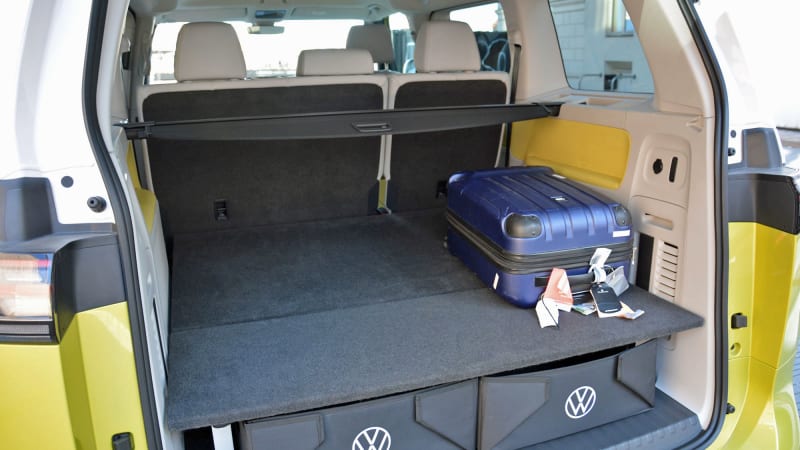
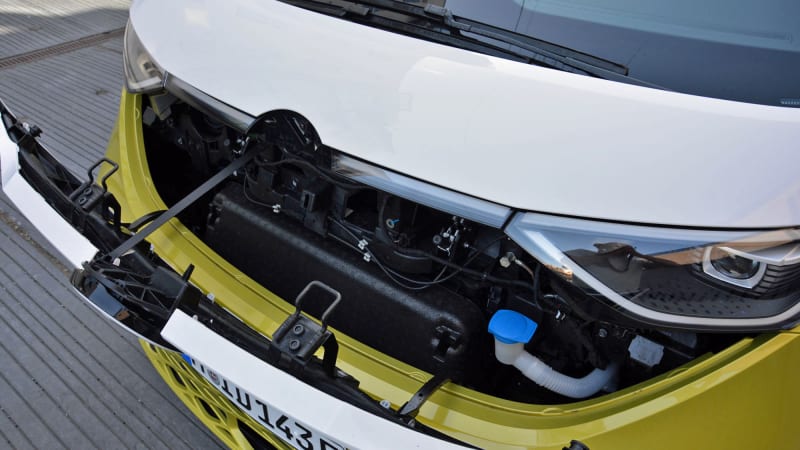
At launch, Volkswagen will offer the European-spec Buzz with a single drivetrain option. Power comes from a rear-mounted permanent-magnet synchronous electric motor that draws electricity from an 82-kilowatt-hour lithium-ion battery pack to zap the back wheels with 204 horsepower and 229 pound-feet of instant torque. The 100 km/h (62 mph) sprint from a stop takes 10.2 seconds and the Buzz keeps accelerating until it reaches 90 mph. Volkswagen notes that’s above the speed limit in a vast majority of countries.
The 204-horsepower rating is sufficient if your vision of the perfect #vanlife is cruising down Highway 1 and stopping for scenic picnics, but it’s a bit short if you need a van that’s just another item in your arsenal of tools. Volkswagen quotes a 2,200-pound towing capacity and a payload of 1,166 pounds, and neither figure is stellar. The turbodiesel-powered Volkswagen Transporter van can tow about 5,500 pounds. Hell, even the last-generation Golf hatchback was rated to tow nearly 4,000 pounds (!) when properly equipped.
Will other powertrains join the portfolio? While this is pure speculation, my crystal ball says yes. The versatile MEB platform underpins the Buzz, so it stands to reason that what’s possible in the ID.4 (like dual-motor all-wheel-drive) is feasible here as well. Don’t hold your breath for a de-tuned version of the Porsche 718 Boxster’s flat-four to really drive the “modern-day Bus” point home; Volkswagen developed the MEB platform exclusively for battery-powered vehicles so the ID. Buzz is all-electric, all the time.
Using a car-derived platform makes the Buzz less van-like to drive than you’d expect considering it looks like the box it came in. Volkswagen Commercial Vehicles developed the model but it feels more like the ID.4 than like the Transporter sold in a number of global markets. It’s easy to drive even in crowded cities: the steering is effortless and the Buzz offers roughly the same turning radius as the much smaller Golf. Visibility is overall excellent, though the hardware that powers the electronic driving aids (like adaptive cruise control) is oddly and distractingly integrated into the bottom part of the dashboard.
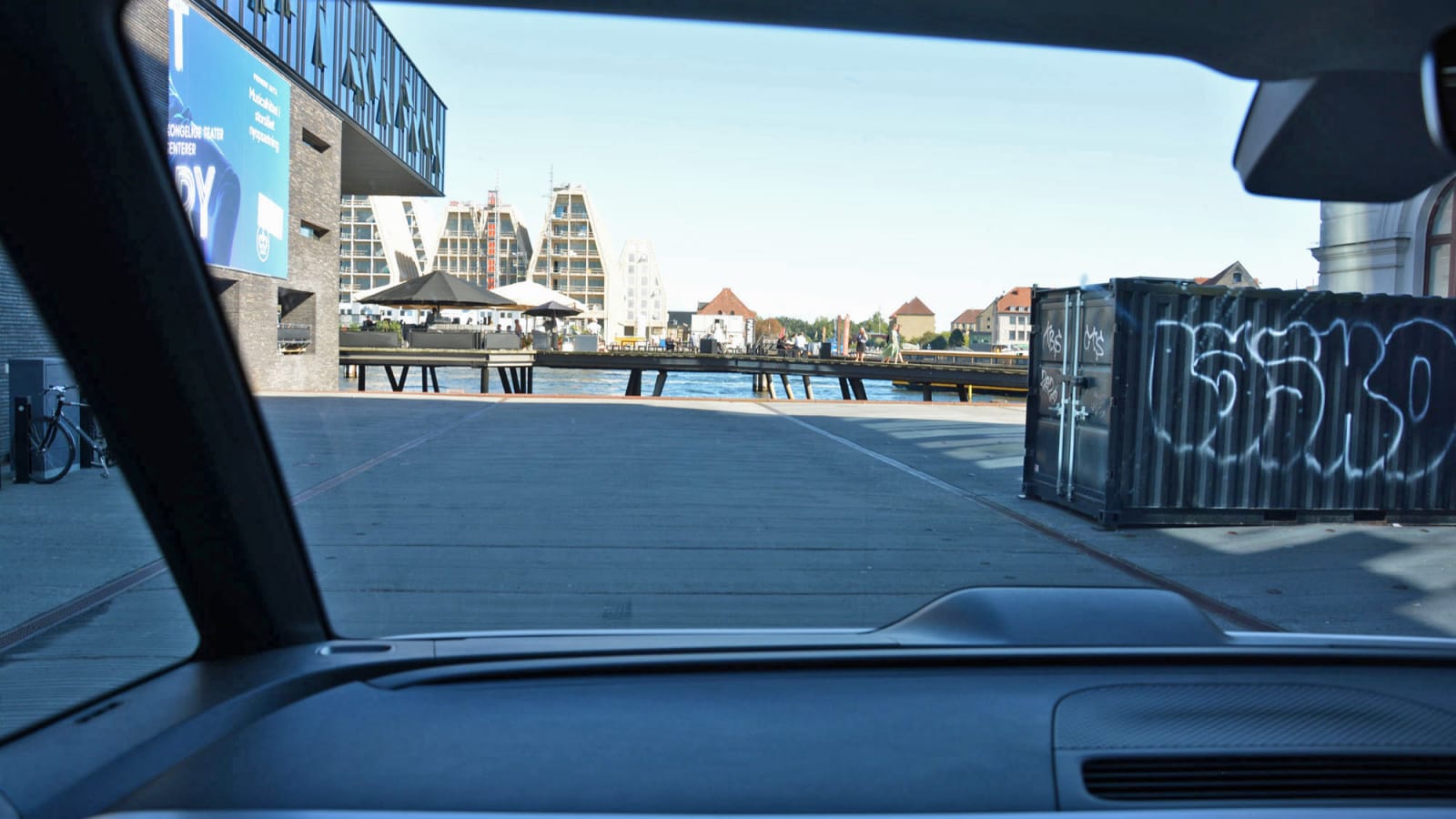
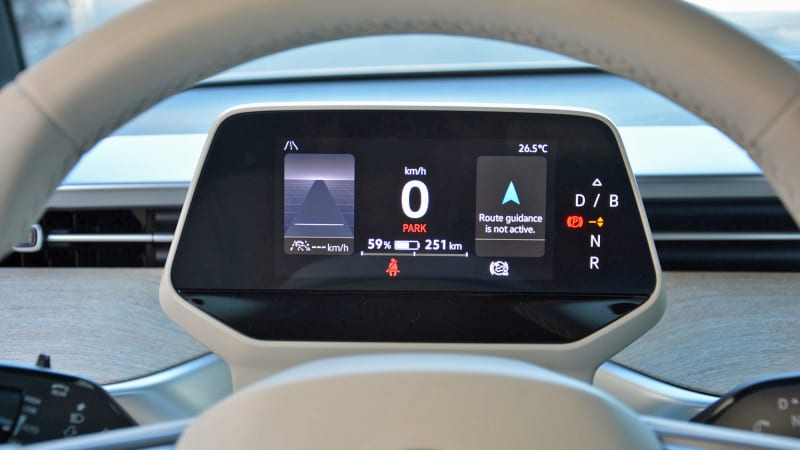
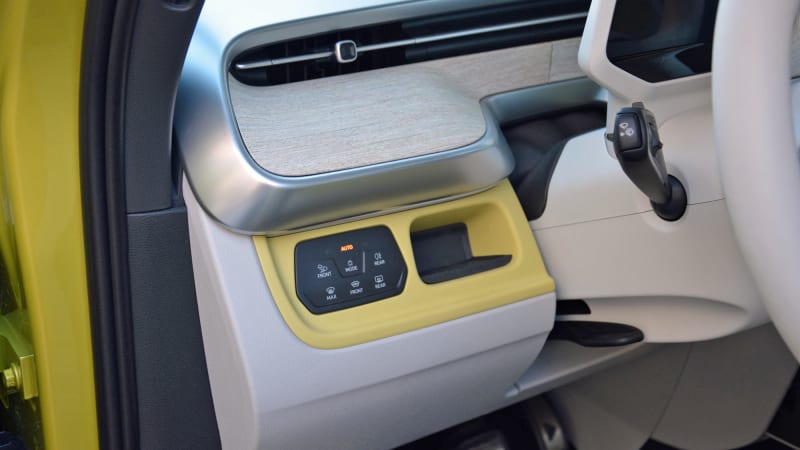
Volkswagen decided not to add a fake engine sound so the Buzz is almost completely silent on the open road; only wind noise and the electric motor’s faint whirrrr permeate the cabin. It accelerates from a stop smoothly thanks to the instant torque and the single-speed transmission but it’s not quick by any means. It’s not supposed to be: it was developed to haul people and their stuff, not to win races.
Integrating the battery pack (which is the heaviest part of the drivetrain by a wide margin) into the platform lowers the center of gravity and makes the Buzz less top-heavy than a comparable gasoline-powered van. There’s some body roll but less than in a Mercedes-Benz Metris, for example. The ride is, in true Volkswagen fashion, pegged on the comfortable side of firm. You’re in for a surprise if you’re expecting the Buzz to float down the road and bounce over bumps like its air-cooled predecessors.
Front discs and — look, another retro feature! — rear drums handle braking, though the regenerative braking system can nearly bring the Buzz to a complete stop when the driver selects the “B” profile. Leaving it in “D” lets the Buzz coast like a gasoline-powered car, and there are no in-between modes. The brake pedal feels a little artificial regardless of the driving mode chosen, a common trait in the EV cosmos, but the system slows down the Buzz predictably and confidently. Volkswagen also programmed Eco, Comfort, Sport, and Individual modes. Eco neuters the powertrain to save range, Comfort is the default profile, Sport sharpens the throttle response, and Individual lets drivers create their own profile.
I didn’t spend enough time behind the wheel to put the Buzz’s driving range or charging capacity to the test. Volkswagen quotes about 263 miles of range on the European testing cycle, which tends to lean towards the optimistic side of the scale, and it notes charging the battery from 5% to 80% takes around 30 minutes when the Buzz draws electricity from a 170-kilowatt quick charger. At the other end of the spectrum, a full charge requires about seven and a half hours when using an 11-kilowatt home charger.
The ID. Buzz’s appeal goes beyond the head-turning, heritage-inspired exterior design. It’s a stylish take on one of the most recognizable cars ever built, as several tourists pointed out in Copenhagen, but it’s also comfortable, laid-back to drive, and spacious enough to rival crossovers. There is no reason to doubt that the longer, American-spec model will be any different, though figures such as pricing and driving range will dictate whether it lands as a strong contender in the EV segment or as an outlier.



